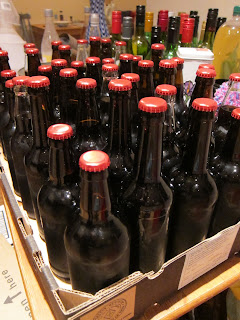Last Monday was another brew day! As
I've got a second fermenter now I decided I'd better fill it! So, time for my
first re-brew... of sorts anyway.
I decided to re-brew my first beer
but to make a couple of slight changes. I decided to use 60 ebc Crystal malt
instead of 120 ebc. I also pushed the hop additions back by 15 minutes. I had a
bottle of the first batch last night, and I still reckon it's good beer, but I
would like to make it a little less heavy and wintral.
I also decided to mash 2C lower than
the original in the hope of getting a slightly lighter body and a drier finish.
Batch #1 finished fermenting at around 1.016 which was higher than I wanted.
I'll be aiming for 1.010 with this batch.
On brew-day I had a bit of trouble
hitting the mash temperature. Adding the grain dropped the temperature further
than Beersmith had indicated, so I had to add more hot water to raise the
temperature back up again. This also meant that I was adding less sparge water
which led to the second runnings sticking a bit and pulling a few grains with
it.
Still, that wasn't the main thing
that went wrong! While the grain was mashing I was weighing out the hops and,
despite the scales being a little erratic, I had everything set up and in
bowls, ready to throw in. Then I happened to notice the IBU level was off the
scale for an American IPA, over 100! This wasn't supposed to be the case! I
realised that by pushing the hop additions back, I was increasing the the IBUs
quite significantly. I also had weighed out the hops but not taken account of
the alpha acid percentages. This is what comes of not preparing properly!
I rejigged the recipe in Beersmith
to reduce the additions only to realise that each timed addition was a mixture
of two hops, so I couldn't tell what I was taking out! In the end I swapped
round two additions, split my late addition in half and threw the remainder in
after the boil! Not exactly a scientific approach but, hey, I'm an artist!
I'm actually really looking forward
to trying this brew, it smells lush and looks good too. I've got an airlock in
the fermenter at the moment, but I know the Californian ale yeast can be a bit
lively, so I might switch that for the blow-off tube tonight. I'll wait and see
what state it's in when I get home!
Oh, and on the subject of hops, I found this little fella in my hops when I unpacked them! Always check your hops!












